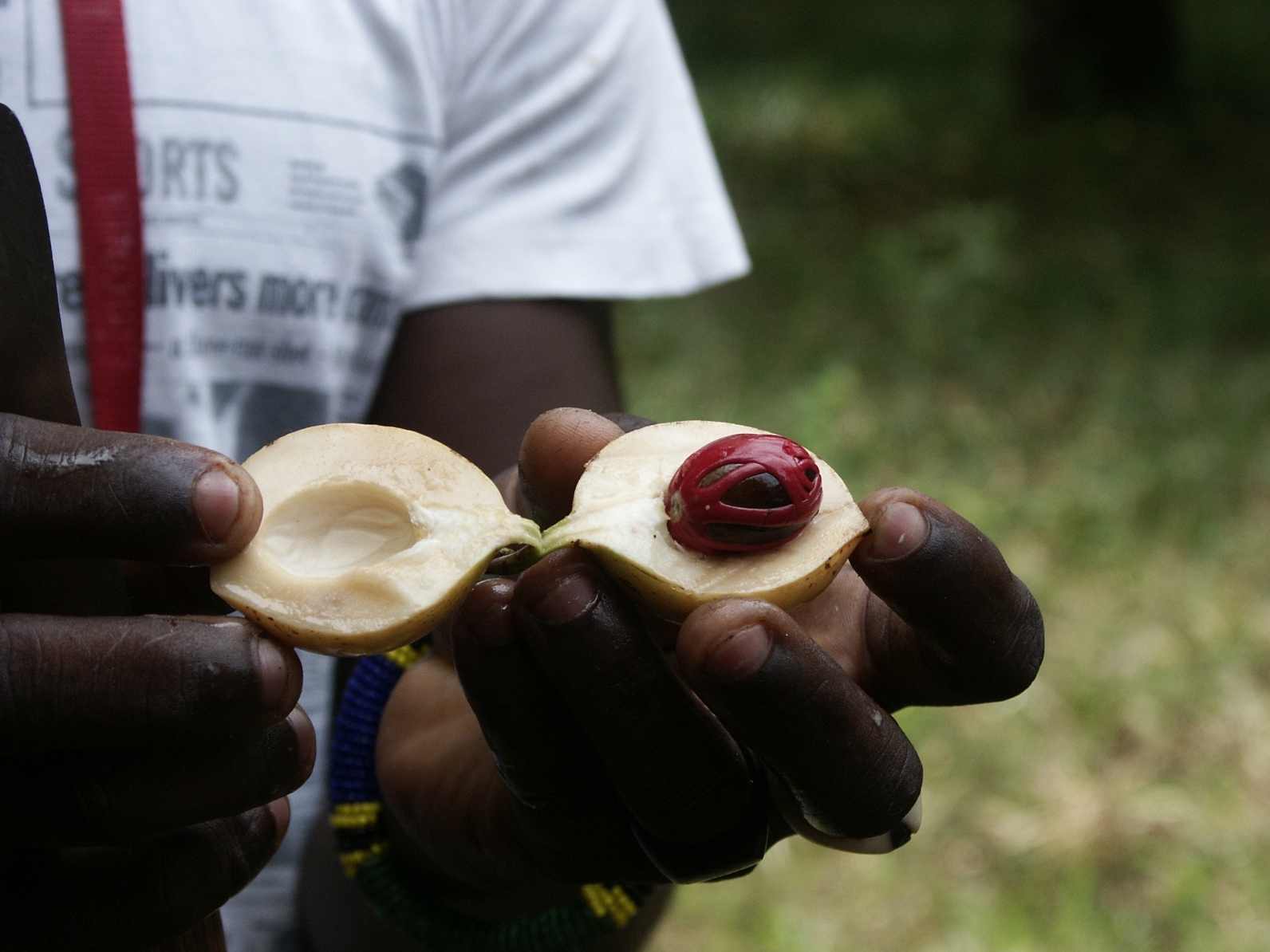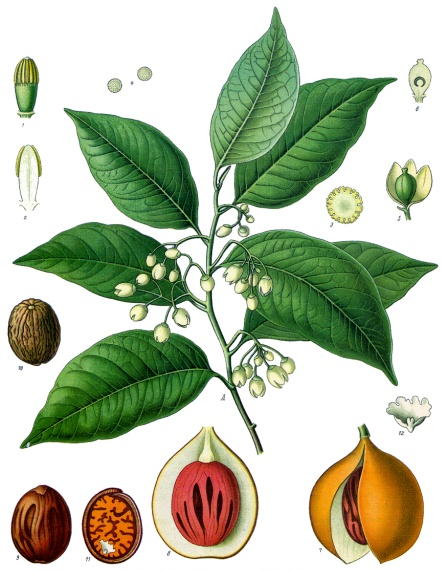
Myristica fragrans (Houtt.)
 Synonyms: Myristica officinalis (L.),
Nux Moschata
Synonyms: Myristica officinalis (L.),
Nux Moschata
Order: Myricaceae
Description: Myristica is a tropical evergreen tree, native to Indonesia and cultivated in the West Indies, South Africa, the Spice Islands and other tropical areas. It grows up to 8m and has a greyish-brown smooth bark. The branches spread in whorls with alternate leaves on petioles 2.5cm long. The leaves are elliptical, glabrous, obtuse at the base, dark green and glossy above with a paler underside, and are 10-15cm long. The small dioecious flowers occur in axillary racemes. The brown, wrinkled oval fruit contains a kernel which is covered by a bright red lacy membrane which is yellowish-brown when dried. This membrane provides the spice mace and the kernel the spice nutmeg.
Parts used: dried kernels, oil
Collection: When the fruit reaches maturity it splits in two to expose
the mace-covered kernel. Mace and kernel are dried separately.
Constituents: at least 5% volatile oil (including pinene, borneol and eugenol) and 35% fixed oil ('nutmeg butter') and small amounts of myristicin and safrol.
Actions: aromatic, carminative, spasmolytic, antiemetic, orexigenic, gastric secretory stimulant, prostaglandin inhibiting anti-inflammatory, cerebral stimulant, antispasmodic, hallucinogenic.
Indications: flatulent dyspepsia, nausea, diarrhoea, dysentery; topically for rheumatism
Therapeutics and Pharmacology: Myrica is of value in the treatment of dyspepsia, nausea, vomiting, diarrhoea (especially if related to food poisoning), dysentery, intestinal spasm, colic, and inflammatory disease of the gut wall. In small quantities it acts on the stomach to improve the appetite and digestion. In trials, it has been used successfully to treat Crohn's disease. In France, it is given in drop doses in honey for digestive upsets and halitosis. Externally, the oil is used for rheumatic pain and, like clove oil, can be applied as an emergency treatment for toothache. Grieve suggests an ointment of grated nutmeg and lard for the treatment of haemorrhoids.
Caution: large quantities are hallucinogenic (thought to be due to myricristin) and excitant to the motor cortex, and can produce stomach pain, double vision, delirium and other symptoms of poisoning. Eating as few as two nutmegs may result in death. A single dose of 7.5g or more may produce convulsions and palpitations.
Preparation and Dosage:
Regulatory Status: GSL
Powdered dry seed, 0.3-1g three times a day.
Oil: Dilute 10 drops in 10ml almond oil and use for muscular pains associated with rheumatism or over-exertion.
Additional Comments: Nutmeg was first brought to Europe from the Banda Islands by the Portuguese around 1512. It gained the reputation of a cure-all and was widely eaten as a tonic. Its hallucinogenic properties were soon discovered. It was erroneously taken to procure abortions and was acclaimed as a cure for the plague. So fashionable did it become in the US, that fake nutmegs were whittles from wood and sold, earning Connecticur the misleading name 'the Nutmeg State'. Known as rou dou kou in China, nutmeg has been used there since the 7th century for stomach problems. Ayurvedic medicine uses it to ease headaches and fever. In folk medicine, the outer fleshy aril of the fruit, mace, was made into an ointment used for rheumatism.
Bibliography
BHMA 1983 British Herbal Pharmacopoeia, BHMA, Bournemouth.
Grieve, M. 1931 A Modern Herbal, (ed. C.F. Leyel 1985), London.
Lust, J. 1990 The Herb Book, Bantam, London.
Mills, S.Y. 1993 The A-Z of Modern Herbalism, Diamond Books, London.
Ody, P. 1993 The Herb Society's Complete Medicinal Herbal, Dorling Kindersley, London.
Richardson, R. 1988 The Little Spice Book, Piatkus, Loughton.
Weiss, R.F. 1991 Herbal Medicine, Beaconsfield Arcanum, Beaconsfield.
Wild, A. 1995 The East India Company Book of Spices, Harper Collins, London.
Wren, R.C. 1988 Potter's New Cyclopaedia of Botanical Drugs and Preparations, C.W.Daniel, Saffron Walden.










